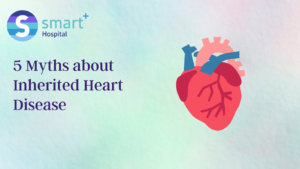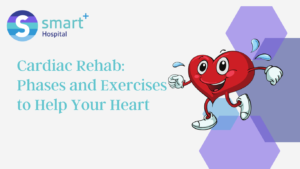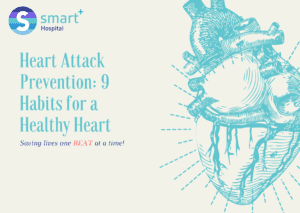Heart disease is a significant health concern in Pakistan, affecting both men and women. Recognizing the warning signs of heart disease is crucial for early detection and prompt medical intervention.
In this article, we will explore the common symptoms and risk factors associated with heart disease, focusing on how they manifest in both men and women.
What is a Heart Disease?
Heart disease refers to a range of conditions that affect the heart’s structure and function. These conditions can include coronary artery disease, heart failure, arrhythmias, and heart valve problems.
Identifying the warning signs can help individuals seek appropriate medical attention and reduce the risk of complications.
What are the Risk Factors for Heart Disease?
Before delving into the warning signs, it’s important to understand the risk factors associated with heart disease. These factors can increase the likelihood of developing cardiovascular problems. Some common risk factors include:
High Blood Pressure: Hypertension is a significant risk factor for heart disease. It puts strain on the heart and increases the risk of heart attacks and strokes.
Smoking: Tobacco use damages blood vessels, reduces oxygen supply to the heart, and contributes to the development of heart disease.
High Cholesterol: Elevated levels of cholesterol in the blood can lead to the formation of plaque in the arteries, obstructing blood flow and increasing the risk of heart disease.
Diabetes: Individuals with diabetes are at a higher risk of developing heart disease due to elevated blood sugar levels that can damage blood vessels over time.
Obesity: Excess weight puts additional stress on the heart, increasing the risk of heart disease.
Family History: A family history of heart disease can significantly increase an individual’s risk.
Warning Signs of Heart Disease
Recognising the warning signs of heart disease is crucial for early intervention and improving outcomes. While symptoms can vary from person to person, there are common signs to watch out for. It’s important to note that these symptoms may manifest differently in men and women.
Common Symptoms in Men
Chest Pain: Men often experience chest discomfort or pain, commonly described as tightness, squeezing, or pressure.
Shortness of Breath: Men may feel breathless even during minimal physical activity or at rest.
Pain in the Arms, Neck, or Jaw: Discomfort, numbness, or pain may radiate from the chest to the arms, neck, or jaw.
Fatigue: Men with heart disease may experience unexplained fatigue and reduced ability to engage in physical activities.
Digestive Issues: Some men may experience indigestion, nausea, or abdominal pain as a symptom of heart disease.
Irregular Heartbeat: Heart palpitations or irregular heartbeat can also be a warning sign of heart disease in men.
Common Symptoms in Women
Chest Discomfort: Women may experience atypical chest pain, which can be sharp, burning, or fleeting.
Shortness of Breath: Similar to men, women may feel breathless even during light physical exertion or rest.
Fatigue: Women with heart disease may feel unusually tired, often to the point of exhaustion.
Back, Neck, or Jaw Pain: Discomfort or pain may be present in the upper back, neck, or jaw.
Sleep Disturbances: Some women may experience sleep disturbances, including insomnia, as a result of heart disease.
Dizziness and Lightheadedness: Women may experience episodes of dizziness or feeling lightheaded, especially with exertion.
Seeking Medical Attention
If you or someone you know experiences any of the warning signs mentioned above, it’s important to seek medical attention promptly. Ignoring the symptoms or delaying medical care can lead to further complications and adverse outcomes.
When visiting a healthcare professional, you have to provide a detailed account of the symptoms experienced. The doctor might perform a physical examination and go through the medical history.
Additionally, he would suggest diagnostic tests like an electrocardiogram (ECG), stress test, or coronary angiography to evaluate heart function and detect any underlying problems.
Prevention and Lifestyle Changes
Prevention plays a vital role in reducing the risk of heart disease. By adopting a heart-healthy lifestyle, individuals can significantly improve their cardiovascular health. Here are some essential lifestyle changes to consider:
Regular Exercise: Engaging in physical activity for at least 150 minutes per week can help strengthen the heart and improve overall cardiovascular health.
Healthy Diet: A well-balanced diet that includes fruits, vegetables, whole grains, lean proteins, and limited saturated fats can promote heart health.
Smoking Cessation: Quitting smoking is crucial for reducing the risk of heart disease. Support from healthcare professionals or cessation programs can be beneficial.
Stress Management: High levels of stress can negatively impact heart health. Adopting stress-management techniques such as meditation, yoga, or engaging in hobbies can be beneficial.
Maintaining a Healthy Weight: Losing excess weight and maintaining a healthy weight can reduce the strain on the heart.
Regular Health Check-ups: Regular visits to a healthcare provider can help monitor blood pressure, cholesterol levels, and overall heart health.
Key Takeaways
Recognizing the warning signs of heart disease is essential for early detection and timely medical intervention. By understanding the symptoms and risk factors associated with heart disease, individuals can take proactive steps towards a heart-healthy lifestyle.
Remember, seeking medical attention at the earliest indication of heart disease can significantly improve outcomes and quality of life.
Get in touch with us for more, or visit our home page





Pingback: Cardiac Rehab: Phases and Exercises to Help Your Heart - Smart Hospital